The big melt: Earth’s ice sheets are under attack
Massive zones are losing ice six times as fast as during the 1980s
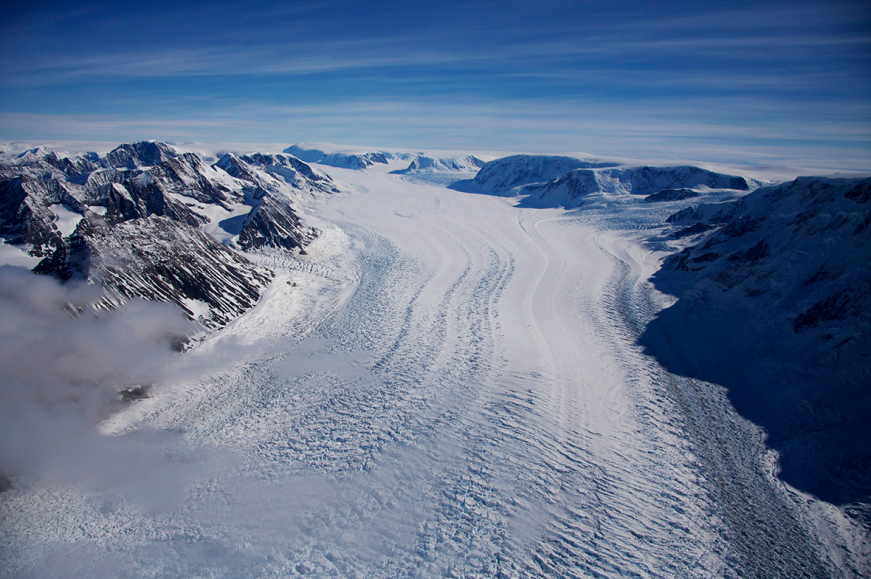
Crane Glacier lost the protective floating ice shelf at its lower edge in 2002. Since then, the glacier has more than tripled its original speed. As the glacier sped up, it also splayed out. This caused its ice to thin in some places by 100 meters (325 feet).
Erin Pettit/Oregon State University
By Douglas Fox
This is the sixth in a 10-part series about the ongoing global impacts of climate change. These stories will look at the current effects of a changing planet, what the emerging science suggests is behind those changes and what we all can do to adapt to them.
December 10, 2012 was an unpleasant day for the people camping on Pine Island Glacier. This slow-moving river of ice sits on a remote coastline of West Antarctica. The ice is up to 3.2 kilometers (two miles) thick. Only a few rocky hills poke above it. Or they look like hills. In fact, they are the tops of huge mountains buried up to their noses in ice.
Despite the ice, this December day was unusually warm. A steady rain pattered onto the wet snow. That made life hard for the scientists.
They were hauling their camp from one place to another. Their snowmobiles swerved back and forth in the sloppy slush. The engines strained and whined, giving off a smell of burnt rubber. And the sleds of gear that being towed behind constantly bogged down, forcing people to hop off and push.
“It was really creepy,” says Dale Pomraning. “Really unexpected.” He is an ice driller from the University of Alaska in Fairbanks.
The rain might seem like a harbinger of global warming. And it is. But Pomraning and the others knew that something even more serious was already underway. Large amounts of ice are melting off this glacier. It’s happening in a hidden place, where humans can’t easily see it.
These 14 scientists had come here to drill several holes, 500 meters (1,600 feet) down through the ice, into the ocean water below. They would lower scientific instruments down through the hole, to study the weak underbelly of Antarctica.
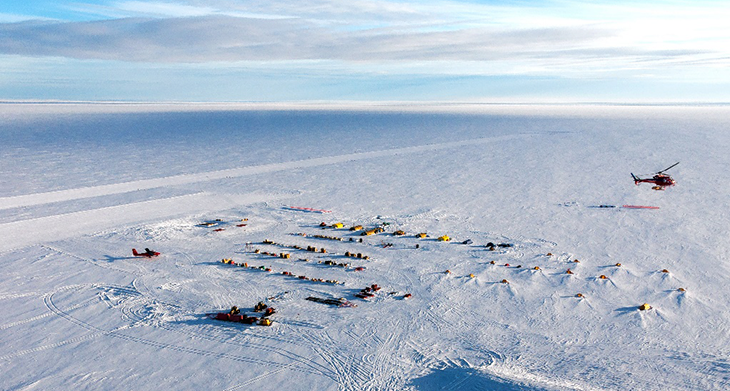
All told, Antarctica has lost three trillion tons of ice since 1992. The rate of ice loss has tripled since 1992. And since 1979, the rate of ice loss has actually increased six-fold — from roughly 40 billion tons per year in the 1980s, to around 250 billion tons per year now.
But things could get much worse.
Scientists fear that by 2100, the rate of ice loss could increase to more than 10 times what it is today. This rapid melt, spread over all of the world’s ice, could raise sea levels an extra 0.6 to 1.8 meters (2 to 6 feet). And if things play out this way, it will be partly because of the oceans.
Deep, warm ocean currents are already melting the edges of Antarctica’s ice from below. The scientists who visited Pine Island Glacier in 2012 were trying to understand how quickly it’s happening — and if it can still be stopped.
Mighty snowflakes
Our planet has three major ice sheets. One, in the Arctic, covers Greenland. Two others, in the south, cover the east and west parts of Antarctica. Collectively, they cover an area almost as large as the United States and Australia combined.
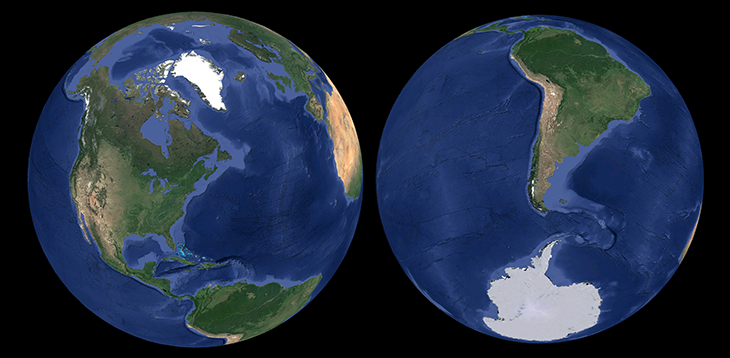
These massive slabs of ice formed from tiny snowflakes that fell over many thousands of years. As this fluffy snow piled up on land, it squished under its own weight, creating solid ice.
The ice is more than 4,000 meters (13,000 feet) thick in some places. Because it is under so much pressure, it bends and oozes like silly putty. So even as snow continues to sprinkle down on Antarctica and Greenland, forming new ice all the time, the old ice beneath it is always spreading outward toward the ocean.
Most of this ice moves only a few meters (yards) per year. But near the coastlines, it speeds up. Huge rivers of ice, called glaciers, flow hundreds — or even thousands — of meters per year. They follow deep canyons in the bedrock beneath them.
As Antarctic glaciers reach the coast, their ice begins to float on the ocean. Most of Antarctica’s coastline is ringed with these floating “ice shelves.” They are hundreds of meters thick. And they do an important job. They hold back the glaciers behind them, slowing their flow into the ocean.
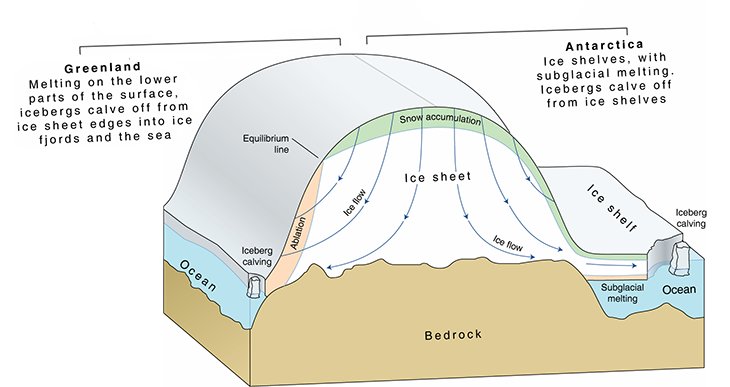
But scientists are worried. Some ice shelves are showing signs of weakness. Deep, warm ocean currents are melting them from below.
Today, Pine Island Glacier’s ice shelf is, on average, about 400 meters (1,300 feet) thick. That’s about equal to the height of New York City’s 102-story Empire State Building. But since 1992, the ice shelf has thinned by 70 meters (roughly 230 feet). And as it has weakened, the glacier has sped up — by 70 percent, just since 1980.
Upside-down canyons
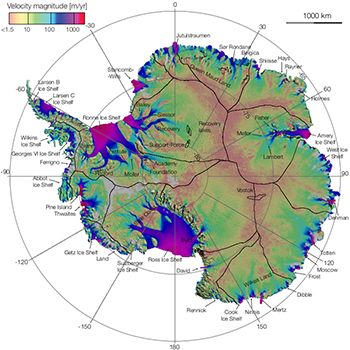
Once Pomraning and the others set up their new camp, they shoveled 3,500 kilograms (7,700 pounds) of snow into a metal tank. They melted it, then ran it through a machine known as a hot-water drill. As its name implies, it uses hot water to melt a narrow hole down through the ice. Once the hole was in place, the researchers lowered scientific instruments through to the ocean below.
Ice was melting off the bottom of the shelf a rate of 6 centimeters (2.4 inches) per day, they found. As warm water flows along the underside of the ice shelf, it melts deep channels into the ice. These upside-down “canyons” cut as far as 180 meters (600 feet) up into the ice shelf. The ice over these canyons no longer supports its own weight. So it sags. The entire ice shelf, 60 kilometers (37 miles) wide and 90 kilometers (56 miles) long, is constantly bending, buckling and breaking as the grooves melt ever deeper into its underside.
Pomraning and the others heard pops and cracks as they slept on the ice shelf at night. They would wake the next morning to find some new crack, a centimeter (four-tenths of an inch) wide — and seemingly bottomless — running between their tents. Some of the cracks on Pine Island Ice Shelf can eventually grow wide enough to swallow a house.
The warm ocean currents assaulting Antarctica are one of the least-recognized aspects of climate change.
Unstoppable heat
As the planet warms, 95 percent of that extra heat is going into a place where we don’t directly feel it. It is seeping into the deep oceans.
Since 1920, the world’s oceans have absorbed 450 zettajoules (ZET-uh-jewls) of heat. That’s enough to melt 1.5 million cubic kilometers (360,000 cubic miles) of ice. That’s enough meltwater to raise global sea levels by 4.3 meters (14 feet). And more heat enters the oceans every day, notes Douglas Martinson. He’s a polar oceanographer at the Lamont-Doherty Earth Observatory in Palisades, N.Y.
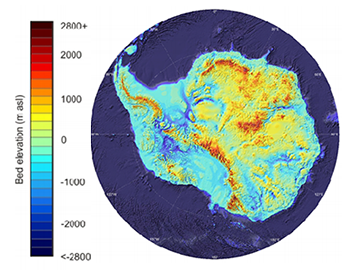
The amount of extra heat in the world’s oceans actually doubled between 1997 and 2015. Ocean currents are only now starting to deliver this heat to Antarctica.
Even if we stop producing carbon dioxide tomorrow, we will “still have all this heat in the ocean,” says Martinson. “It’s hard to imagine how we’re going to shut this off.”
People like Robert DeConto are trying to figure out how the world’s ice sheets will respond to this heat. He is a glaciologist at the University of Massachusetts in Amherst. And he has created computer models. These simulations show how Antarctica’s ice will likely change as the world gradually warms.
The world has so far warmed about 1 degree Celsius (1.8 degrees Fahrenheit) since 1850. As warming increases to 1.5 and then 2 degrees C (2.7 and then 3.6 degrees F) over the coming decades, Antarctica will gradually lose more ice. At first it would not be dramatic, says DeConto. But his simulations show that when the warming hits 3 degrees C (5.4 degrees F), “all hell breaks loose.”
His computer models show that at this point, West Antarctica’s ice shelves will be under attack from two directions at once. They will continue to melt from the ocean below. And they will also start to feel serious effects from the warming air above.
Shattering ice
Warm summers will melt snow on top the ice shelves, forming vast blue ponds. “A lot of liquid water on the ice shelves is not a good idea,” observes DeConto.
The water from those lakes drains into deep cracks in the ice, called crevasses (Kreh-VOSS-sez). The weight of the water drives the cracks ever deeper — until they break through bottom of the ice. If this happens with many crevasses at once, an entire ice shelf can shatter in a period of days. Three thousand square kilometers (1,160 square miles) of ice shelf can disintegrate into a swarm of icebergs that drift away into the ocean.
This has already happened in a warmer part of the continent, called the Antarctic Peninsula. This finger of land stretches up toward the bottom tip of South America. And since 1988, four of its ice shelves have disintegrated. They have fallen like dominoes, from north to south, as warm summers reach farther down the peninsula.
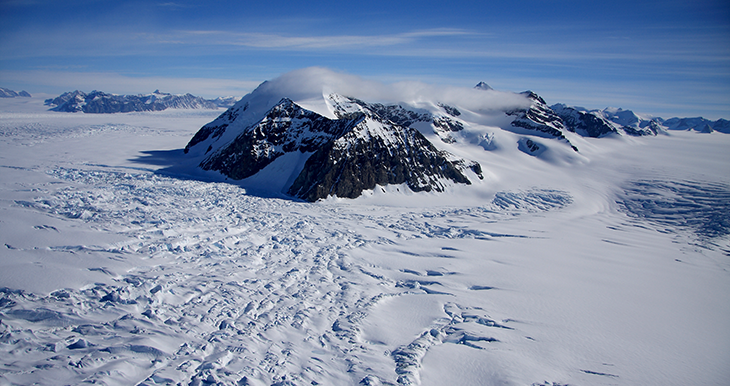
When the Antarctic Peninsula’s ice shelves collapsed, the glaciers that they had been holding back rampaged out of control. Those glaciers were then flowing two to nine times their original speed. This dumped ice into the ocean faster than ever.
The Antarctic Peninsula does not hold enough ice to raise sea levels more than a few centimeters. “But it showed us what could happen” farther south in West Antarctica, says Ted Scambos. He’s a glaciologist at the National Snow and Ice Data Center in Boulder, Colo.
Greenland’s fastest glacier
Scambos believes that if large glaciers in West Antarctica suddenly lose their entire ice shelf, it could be even worse. Right now, these glaciers end in cliffs of ice that rise about 30 meters (100 feet) above the water. That’s about as high as a seven-story building. But if the floating ice shelf breaks off the front of the glacier, it exposes a taller cliff of ice. And if the cliff gets too tall, the ice will no longer be strong enough to support its own weight. When that happens, Scambos warns, “the ice fails almost instantly.”
Scientists learned this from watching a glacier in Greenland. Called Jakobshavn, it lost the floating ice off its front between 1998 and 2002. The ice cliff at the head of the glacier now towers 100 meters (about 325 feet) above the water — as high as a 20-story building. Every few days, it collapses with a deafening roar. Icebergs as big as apartment buildings pile up in the water in front of it. They briefly clog up an ocean bay, called a fjord in front of the glacier. That fjord is 13 kilometers (8 miles) across. Within a few days, however, those blocks drift away. This gives the ice cliff space to collapse again.
Jakobshavn is now losing 13 kilometers of ice off its front face every year. That’s faster than any other glacier in the world. But if glaciers in West Antarctica succumb to summer melting, and lose their floating ice shelves, it could be even worse.
West Antarctica has several dozen large coastal glaciers. And researchers have become especially worried about one. Called Thwaites Glacier, it sits 100 kilometers (roughly 60 miles) west of Pine Island.
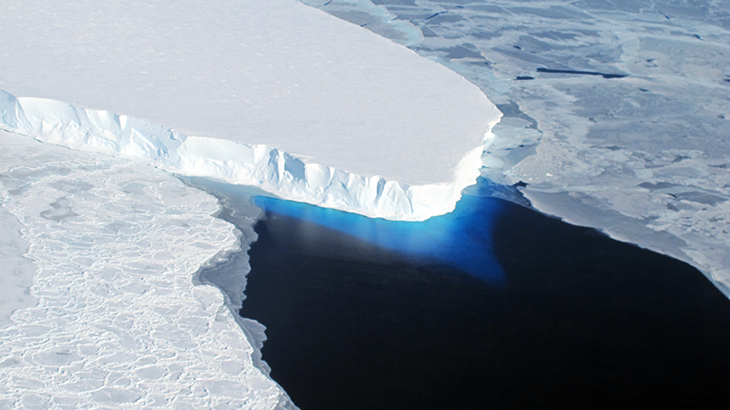
Deep and dangerous
The front of Thwaites, where it touches the ocean, sits in water 600 meters (2,000 feet) deep. But as you go farther inland, the bed of the glacier slants downward. This deepening groove connects all the way to the center of West Antarctica, 500 kilometers (310 miles) inland. There, the ice is up to 3,400 meters (11,000 feet) thick. And it sits in a bowl that plunges as far as 2,500 meters (8,200 feet) below sea level.
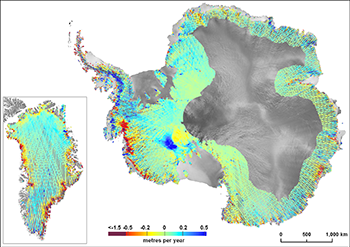
This geography sets up a bad situation. As the ice cliffs of Thwaites begin to crumble some years from now, each collapse will expose an even taller cliff behind it. And these progressively higher cliffs could collapse more and more quickly.
As the glacier front retreats into deeper water, it will also receive more and more heat from deep ocean currents. And here’s another concern: Thwaites Glacier is 120 kilometers (75 miles) across — eight times wider than Jakobshavn. And unlike Jakobshavn, it isn’t walled in by mountains on either side. So the ice blocks that tumble down might not pile up and protect the new cliff face, even for a short while.
Scambos imagines what a full-blown collapse of Thwaites Glacier might look like, 50 or 100 years from now. ”You’d see this ripple effect of crumpling glacier,” he says. The wave of collapse would expand a few kilometers further into Antarctica each year, as ice tumbled in from all sides. At this point, he says, ”you’re really ripping out the icy heart of the continent.”
Some regions of West Antarctica are thought to be stable right now. They aren’t exposed to as much deep warm water as the Amundsen Coast, where Pine Island and Thwaites sit. But the collapse of Thwaites could rip open the back doors on those glaciers, too.
As the wave of collapse eats into their rear ends, those supposedly stable glaciers could actually change direction, and flow backward. They could spill their ice into the widening hole at the center of the continent. Scambos says it’s “just like digging out the center of a big sand pile.”
Changing predictions
Scientists used to think that Antarctica and Greenland would resist the effects of global warming, at least for the next 100 years or so. They believed that warmer oceans would cause more water to evaporate. This would make more clouds — and drop more snow onto the ice sheets. Many scientists predicted that more snowfall would offset the effects of faster melting. A major 2001 report by the Intergovernmental Panel on Climate Change (IPCC) still voiced this opinion. But since then, things have changed quickly.
Antarctica’s rate of ice loss has increased by six-fold since 1979. And between just 2000 and 2004, Greenland’s rate of ice loss also nearly tripled.
Antarctica is now losing some 250 billion tons of ice per year. In places like Canada, Alaska and the high mountains of Asia and South America, the world’s smaller glaciers are collectively losing 215 billion tons per year. And Greenland is losing about 280 billion tons of ice per year.
But among these masses of ice, Antarctica is the sleeping giant. It holds 85 percent of the world’s ice. That’s seven times as much as Greenland and all of the world’s other glaciers combined. And compared to Greenland, much more of Antarctica’s ice sits in deep basins, vulnerable to ocean heat. So as the world continues to warm, the growing heat will attack Antarctica from both the air and the sea. And within a few years, Antarctica will become the leading contributor to sea level rise.
New worries
West Antarctica holds enough ice to raise sea level by 3 meters (10 feet). The continent’s other half, East Antarctica holds four times as much ice as the west. Scientists had thought that East Antarctica’s ice sat on high ground, protecting it from warm ocean currents.
But scientists have since realized that this is not true. They have spent a decade using a method, called ice-penetrating radar, to map the mountains and valleys under East Antarctica’s ice. Those studies have shown that vast swaths of this ice sheet sit in ocean basins that dip 1,000 to 2,500 meters (3,300 to 8,200 feet) below sea level. That’s just as deep as West Antarctica.
Just two of these glaciers in East Antarctica — called Totten and Denman — hold enough low-lying ice to raise sea levels by 5.5 meters (18 feet). In other words, these two glaciers by themselves could raise sea levels by more than all of West Antarctica combined.
If these glaciers become unstable, “then you’re really in trouble,” says Helen Fricker. She’s a glaciologist at the Scripps Institution of Oceanography in San Diego, Calif. “These are the places that keep me up at night.”
On September 15, 2018, NASA launched a satellite into orbit that will help Fricker monitor the situation. The craft is called the IceSat-2. (That’s short for Ice, Cloud and land Elevation Satellite 2.) It will orbit 15 times per day. As it passes overhead, it will send a laser beam down to the surface to measure the of glaciers and ice shelves below. This laser altimeter can show Fricker how quickly ice shelves like Totten and Thwaites are thinning. (At the end of January, Fricker and other researchers were still testing IceSat-2, to make sure that it’s taking accurate measurements. Within a few months, the satellite should begin providing an updated view of the ice sheets.)
And starting last November, the United States and the United Kingdom began a four-year research project at Thwaites Glacier. They are putting teams of scientists on the glacier and its ice shelf to better understand how it is responding to the slow, feverish rise in Earth’s surface temperatures.
Already melting
Old satellite measurements have shown that already in the mid-2000s, the ice shelves in front of Thwaites and other nearby glaciers were thinning, each year, by up to another 6 meters (20 feet). One ice shelf in front of nearby Smith Glacier actually thinned by 490 meters (1,600 feet) between 2002 and 2009. The thinning of all of these ice shelves was due to ocean melting on their undersides.
But people studying Thwaites want to know how soon the other line of attack will begin: the heavy summer melts that form ponds on top the ice shelves. Those ponds will set the stage for the shelves to shatter into thousands of pieces and drift away. That’s what happened on the Antarctic Peninsula.
The scientists who visited Pine Island in 2013 could already see the earliest signs of this.
When they arrived on the ice shelf, their first job was to dig out equipment that had been dropped off by airplanes the year before. The snowmobiles and barrels of fuel were buried in snow — visible only from flags that marked their positions.
But as Pomraning and his friends began to dig, they made a surprise discovery. Beneath the surface of that snow were thick rinds of ice. They took two days to chip their snowmobiles out of it.
That solid ice had formed the summer before, as warm air melted the snow. It left pools of water that trickled down and re-froze. No one was there to see it happen, but the assault from the air had already begun.







